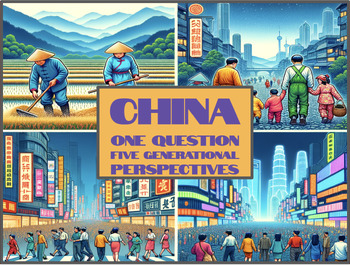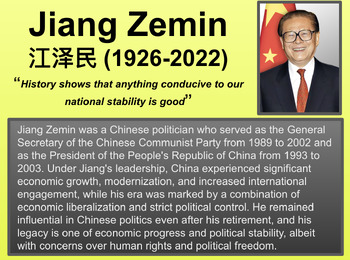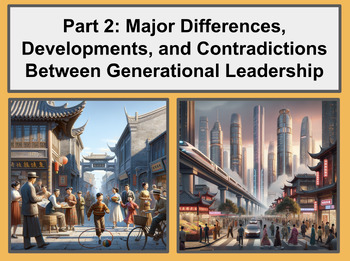China: One Question, Five Generational Perspectives
- Google Drive™ folder

Description
“China: One Question, Five Generational Perspectives” is a set of resources delving into the changing politics of the Chinese leadership over a seventy year period. This resource contains five files:
Google Slides (31 slides)
Highlighting the background and achievement of five generational Chinese leaders; Mao Zedong, Deng Xiao Ping, Jiang Zemin, Hu Jintao, and Xi Jinping.
- Part 1 gives a summary and major achievements of each
- Part 2 Major differences, developments, and contradictions between generational leadership
- Part 3 looks at ten major changes from Mao to Xi and also ten things that have changed very little over the last 70 years.
Google Doc (12 pages)
The purpose of the document is to provide comparative insights on various questions as if answered by five significant Chinese leaders: Mao Zedong, Deng Xiaoping, Jiang Zemin, Hu Jintao, and Xi Jinping at the time of their leadership. Each response embodies the philosophies and policies prevalent during each leader's tenure.
The responses to the 10 questions posed have been generated using AI. This particular bot was prompted to:
- Develop and present unique responses to each question asked, with each response reflecting the distinct leadership style and era of the specified Chinese leader.
- Maintain historical accuracy and incorporate relevant ideologies and key events that would influence each leader's answer.
The questions asked were as follows;
- What is your primary objective for China's national development and what strategies do you employ to achieve it?
- How do you define the role and power of the Chinese Communist Party in governing the country, and how does this shape your approach to political reforms?
- What is your assessment of China's relationship with the United States, and how do you seek to manage this critical bilateral tie?
- How do you plan to address the growing socioeconomic disparities within China, particularly between urban and rural areas, and among different regions?
- What is your vision for strengthening China's international influence and global standing, and what specific foreign policy tools do you utilize?
- How do you balance the imperatives of economic growth and modernization with the imperative of maintaining social stability and ideological control?
- What is your stance on the role of individual rights, civil liberties, and pluralism within the Chinese political and social framework?
- How do you seek to promote traditional Chinese culture and values on the global stage, and what is the relationship between this and your nationalist agenda?
- What are your key strategies for addressing China's environmental degradation and ensuring sustainable development for the future?
- How do you envision the evolution of China's relationship with its ethnic minority populations, particularly in regions like Xinjiang and Tibet?
Google Doc (3 Pages)
Suggestions for potential lessons, activities and projects (20 suggestions in all).
Google Forms (2)
- Slide-related Google Form (6 multiple choice questions, 6 short-answer questions, 2 open-ended questions)
- Doc-related Google Form (6 multiple choice questions, 6 short-answer questions, 2 open-ended questions)





